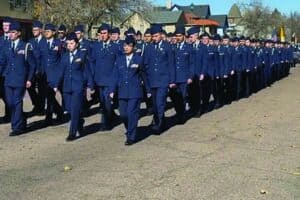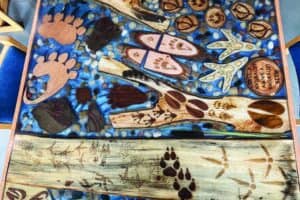Eastonville Road runs through Falcon from Meridian Road to Meridian Ranch Boulevard. A few blocks north of Meridian Ranch Boulevard, Eastonville Road turns to dirt.Until the new Falcon High School opened last fall, Falcon residents had little reason to drive the dirt part of Eastonville Road. They still have little reason to drive the road to its terminus at Evans Road, about 15 miles north of Falcon.If they were to make that drive, they would not find a town called Eastonville. So, where is Eastonville?Other than Eastonville Road, the Eastonville cemetery at the intersection of Meridian Road and Latigo Boulevard is the only visible clue there was ever a town called Eastonville.According to a paper titled “The History of Eastonville, Colorado” by Charles M. Hobbs, published by the State Historical Society of Colorado in 1950; there was a town called Eastonville. And it sprang to life as a stop along the Denver & New Orleans Railroad, which was built in 1882.The railroad connected Eastonville to Elbert, Elizabeth, Parker and Denver to the north and Falcon, Manitou Junction (now the intersection of Highway 24 and Highway 94), Colorado Springs and Pueblo to the south.A copy of a hand-written map provided by Black Forest resident Ruth Ann Steele indicates that Eastonville was located about eight miles north of Falcon, along Sweet Road between Eastonville Road and Elbert Road.Eastonville took its name from a settlement founded in 1872 called Easton. Easton was located about a fifth of a mile west of the Eastonville cemetery, Steele said.Easton had a post office, and mail was carried there by horseback from Colorado Springs, wrote Hobbs.With the establishment of train service, local residents wanted to move the post office from Easton to the train depot, but the government refused, citing potential confusion between Easton and a town named Eaton in Weld County.”It was decided to call the new office and station Eastonville, and it has been so since,” Hobbs wrote. Before the name change, the town was called McConnellsville.Steele’s collection of Eastonville papers includes notes of an interview with Jim Valentine in 1991. Valentine said the name of Eastonville became official Sept. 28, 1883, with John Brazelton as postmaster.Hobbs wrote that Brazelton owned Eastonville’s first store, which was eventually sold to the Russell Gates Mercantile Company. Gates erected a larger store “which lay in an ‘L’ shape and had about 400 feet lineage and was a two-story affair. Business was good, and they soon added a big lumber yard and a creamery.”According to the interview with Valentine, in 1890, Eastonville had three blacksmiths, a postmaster, a printer, a physician, a sawmill, a meat market, a hotel, a station agent, a painter, a justice of the peace and three general merchandise stores.By 1893, the town had added two carpenters, a shoemaker, a bakery, two churches (Episcopal and Presbyterian), a fourth blacksmith, four hotels, a newspaper (the Eastonville World, a weekly) and a school.Hobbs wrote that the school had 70 or 80 children in attendance and employed four teachers.By 1896, Eastonville had acquired a Baptist church, a stationery and confectionary store, a jeweler, a dressmaker, a notary public and a drug store, plus additional carpenters, physicians and blacksmiths.The Wikipedia entry for Eastonville states that by the 1900s Eastonville had a population of 350 to 500 people.”For many years,” Valentine said, “the region was known as a great grain and potato growing area. Whole trainloads of potatoes were shipped. During the last part of the 19th century, there were long freight trains every day and six or eight passenger trains.”The Eastonville depot was so busy that the depot never closed, Hobbs said.Hobbs wrote that Eastonville was surrounded by a splendid farming community. “Two pound spuds were common, and there was a great demand for the seed of these dry land potatoes. Trainloads of potatoes were shipped from Eastonville and Monument. Annual potato bakes were held in each place.”Hobbs also recalled the Eastonville creamery, which “made a wonderful record in butter and cheese making and took numerous blue ribbons on their Blue Hill Products at county fairs throughout the country.”Eastonville’s decline started when the railroad company rerouted passenger trains to the Santa Fe Railroad, Valentine said. Then, trucks took over a large part of the freight business.From 1931 to 1934, the entire Pikes Peak area experienced a drought. “In some instances, grass didn’t even sprout through the summer,” wrote Loren Whittimore in his book, “An Illustrated History of Ranching in the Pikes Peak Region.”When the Memorial Day flood of 1935 wiped out the tracks between Eastonville and Elbert, the railroad company “seized the opportunity to discontinue business,” Valentine said.The flood was the result of the Kiowa River jumping its banks in the evening, said Steele, who lives on Evans Road and whose land is scarred by erosion caused by the flood. “It must have been horrendous. The flood waters wiped out Colorado Springs.”After the flood, the potato crops failed. Steele said she believes the failure was caused by a fungus similar to the fungus that caused the Irish potato famine.”This must have been wonderful potato country,” Steele said. “You can plant potatoes here still, and the first year they are wonderful. They taste like they have cream in them. They are creamy white and they are just delicious. They are enormous.”The second year, they are smaller and yellowish, and the third year you can’t eat them. They look like they are dying of thirst, but they have plenty of water. So the fungus is still here.”With the potato blight and the railroad gone, “people moved away and finally there were no pupils in the school,” Valentine said. “Dairy farming was no longer profitable, so the cheese factory was closed forever.”Hobbs wrote that after the flood, the Gates mercantile store began to disintegrate. “Houses were torn down and moved out. The post office was discontinued. Stockyards were torn down. In a few years, only a few buildings were left of what once was a very prosperous place.”Steele said the path of the railroad can still be seen in the mounds that follow the east side of Eastonville Road toward Falcon. “I’ve heard stories that there is an enormous engine buried somewhere deep in the sand along the railway,” Steele said. “But I think maybe it’s an old-wives tale.”






